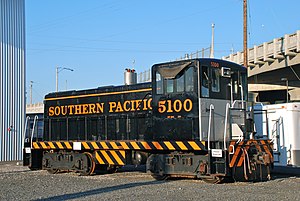The Pennsylvania Railroad, legal name The Pennsylvania Railroad Company, also known as the "Pennsy", was an American Class I railroad that was established in 1846 and headquartered in Philadelphia. It was named for the commonwealth in which it was established. At its peak in 1882, the Pennsylvania Railroad was the largest railroad, the largest transportation enterprise, and the largest corporation in the world.

The American Locomotive Company was an American manufacturer of locomotives, diesel generators, steel, and tanks that operated from 1901 to 1969.

A diesel locomotive is a type of railway locomotive in which the power source is a diesel engine. Several types of diesel locomotives have been developed, differing mainly in the means by which mechanical power is conveyed to the driving wheels. The most common are diesel-electric locomotives and diesel-hydraulic.

The Little Joe is a type of railroad electric locomotive built by General Electric. The locomotives had twelve axles, eight of them powered, in a 2-D+D-2 arrangement. They were originally intended to be exported to the Soviet Union and designed to operate on Soviet Railways (SZhD) 3,300-volt DC overhead line system. They were never exported to the Soviet Union due to rising political tensions. Only 20 were built, with 15 sold to domestic operators and five exported to Brazil.
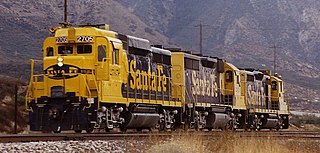
The EMD GP30 is a 2,250 hp (1,680 kW) four-axle diesel-electric locomotive built by General Motors Electro-Motive Division of La Grange, Illinois between July 1961 and November 1963. A total of 948 units were built for railroads in the United States and Canada, including 40 cabless B units for the Union Pacific Railroad.

A camelback locomotive is a type of steam locomotive with the driving cab placed in the middle, astride the boiler. Camelbacks were fitted with wide fireboxes which would have severely restricted driver visibility from the normal cab location at the rear.
Early Electro-Motive Corporation switcher locomotives were built with Winton 201-A engines. A total of 175 were built between February 1935 and January 1939. Two main series of locomotives were built, distinguished by engine size and output: the straight-8, 600 hp (450 kW) 'S' series, and the V12, 900 hp (670 kW) 'N' series. Both were offered with either one-piece cast underframes from General Steel Castings of Granite City, Illinois, denoted by 'C' after the power identifier, and fabricated, welded underframes built by EMC themselves, denoted by 'W'. This gave four model series: SC, SW, NC and NW. Further developments of the 900 hp (670 kW) models gave model numbers NC1, NC2, NW1, and NW1A, all of which were practically indistinguishable externally from the others, as well as a pair of unique NW4 models for the Missouri Pacific Railroad and a solitary, twin-engined T transfer locomotive model built for the Illinois Central Railroad.

The EMD SW1 is a 600-horsepower (450 kW) diesel-electric switcher locomotive built by General Motors' Electro-Motive Corporation between December 1938 and November 1953. Final assembly was at EMD's plant at LaGrange (McCook) Illinois. The SW1 was the second generation of 3,402 cu in (55.75 L) switcher from EMD, succeeding the SC and SW. The most significant change from those earlier models was the use of an engine of EMD's own design, the then-new 567 engine, here in 600 hp (450 kW) V6 form. 661 locomotives of this design were built, with a gap in production between March 1943 and September 1945 due to World War II.

A gas turbine locomotive is a type of railway locomotive in which the prime mover is a gas turbine. Several types of gas turbine locomotive have been developed, differing mainly in the means by which mechanical power is conveyed to the driving wheels (drivers). A gas turbine train typically consists of two power cars, and one or more intermediate passenger cars.

The GE B30-7 is a diesel-electric locomotive model produced by GE from 1977 to 1983 as part of their Dash 7 Series, featuring a 16 cylinder engine producing 3,000 horsepower. A total of 399 units were produced, including 120 cabless B30-7A units. The B30-7AB/A(B) is an unofficial model. The B30-7 was GE's successor to the U30B.
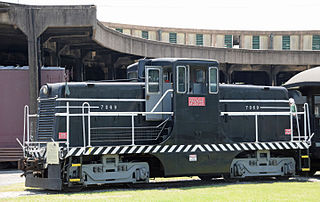
The GE 44-ton switcher is a four-axle diesel-electric locomotive built by General Electric between 1940 and 1956. It was designed for industrial and light switching duties, often replacing steam locomotives that had previously been assigned these chores.
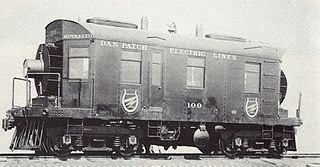
Before diesel engines had been developed for locomotive power in the 1920s and 1930s, many companies chose to use the gasoline engine for rail motive power. The first GE Locomotive was a series of four-axle (B-B) boxcab gasoline-electric machines closely related to the "doodlebugs", self-propelled passenger cars built in the early Twentieth Century.

The GE C40-8W is a 6-axle diesel-electric locomotive built by GE Transportation Systems from 1989 to 1994. Often referred to as the Dash light series, it is part of the GE Dash 8 Series of freight locomotives. This locomotive model is distinguished from the predecessor Dash 8-40C by the addition of a newer "wide" or "safety" cab. A cowl-bodied version of this locomotive, built only for the Canadian market, was the GE Dash 8-40CM.
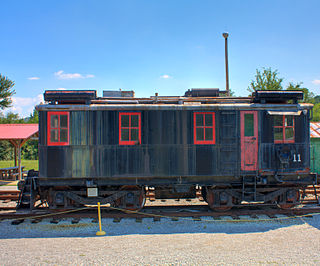
The ALCO boxcabs were diesel-electric switcher locomotives, otherwise known as AGEIR boxcabs as a contraction of the names of the builders. Produced by a partnership of three companies, ALCO built the chassis and running gear, General Electric the generator, motors and controls, and Ingersoll Rand the diesel engine. The principle of operation was the same as modern locomotives, the diesel engine driving a main generator of 600 volts DC with four traction motors, one per axle.

The GE 80-ton switcher is a diesel-electric locomotive model built by GE Transportation Systems. It is classified as a B-B type locomotive. It was designed for industrial and light switching duties around railheads and ports.

The GE 45-ton switcher is a 4-axle diesel locomotive built by General Electric between 1940 and 1956.

The GE boxcabs, sometimes also GE IR boxcabs, were diesel-electric switcher locomotives succeeding the ALCO boxcabs. The locomotives were built by General Electric and Ingersoll Rand without ALCO. Production lasted from 1928 to 1930. These boxcabs were often termed oil-electrics to avoid the use of the German name Diesel, unpopular after World War I.

The Dash 9 Series is a line of diesel locomotives built by GE Transportation. It replaced the Dash 8 Series in the mid-1990s, and was superseded by the Evolution Series in the mid-2000s. Dash 9 series locomotives are some of the most common in the United States.

The GE 25-ton switcher is a model of diesel-electric switcher locomotive that was produced by GE Transportation at their Erie, Pennsylvania, facility between 1941 and 1974. Most examples were produced for industrial customers or the United States Armed Forces, although a number of examples were purchased by freight railroads as well. The majority of production was for customers in the United States and Canada, but export models were produced for buyers on five continents. Production totaled approximately 550 units over 33 years, making it one of the most widely produced switchers in American history.
